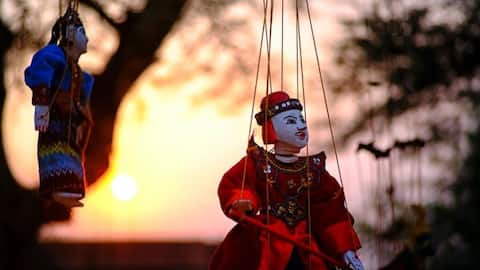Threads of tales: Exploring Indian puppetry
What's the story
Puppetry is an ancient form of storytelling and entertainment that has been an integral part of Indian culture for centuries.
Different regions showcase their unique styles and traditions in this unique form of living art.
From playful shadows to enchanting string puppetry, tradition meets storytelling in a captivating dance of colors and craftsmanship.
Here are some key aspects of puppetry in India.
Shadow puppetry
Andhra Pradesh
Tholu Bommalata, meaning "dance of leather dolls" in Telugu, is a distinctive form of shadow puppetry practiced in Andhra Pradesh and Telangana.
This hereditary craft is carried forward by the Aare Kapu community and reflects a rich cultural heritage.
Notably, Tholu Bommalata stands out for its large puppets, ranging from 1 to 2 meters, with varying dimensions and poses for principal characters.
Rod puppetry
Tamil Nadu
Tamil Nadu's Bommalattam puppets fuse rod and string puppetry, crafted from wood.
Manipulated by puppeteers donning an iron ring crown, these marionettes stand out as the most articulate, largest and heaviest among traditional Indian counterparts.
Bommalattam puppet shows are staged in temples during diverse festivals, with performances extending over a week or ten days, often spanning through the night.
String puppetry
Rajasthan
Kathputli, crafted from wood or "kath," characterizes traditional Rajasthani puppets.
The itinerant puppeteers, known as Nats or Bhats, belong to Rajasthan's wandering community. They showcase their performances, or "khel," during the dry season and later return to their villages for agricultural pursuits post the rains.
Unlike many Indian puppetry traditions centered around Ramayana or Mahabharata, Rajasthani puppet shows predominantly narrate tales of local heroes.
Glove puppetry
Kerala
Pavakothu features leather puppets used to narrate tales from the Mahabharata and Ramayana. It is mainly performed in temple festivals in 21 parts.
Crafted from vegetable dyes for enduring color, these puppets, reaching up to four feet in height, are controlled with two sticks.
The puppeteer holds the puppet with one hand, and deftly manipulates the limbs using a slender stick in other hand.
Rod
Bihar
The puppetry Yampuri portraying Lord Yam, the god of death, originated in Uttar Pradesh and subsequently made its way to Bihar, where it is currently vividly practiced.
Crafted from wood and controlled by strings, the puppets in this art form differ from the conventional rod puppets of West Bengal and Odisha.
In contrast to their counterparts, these puppets are single-piece creations without joints.
String
West Bengal
Referred to as both "Dang Putul" and "Daanger Putul," Daanger Putul Naach is a rod puppetry tradition originating in West Bengal.
Meaning "rod doll dance" in translation, this art form is heavily influenced by Jatra, a popular folk-theatre, incorporating elements such as costume, repertory, music, and dialogues from the folk theatre tradition.
It is performed in a makeshift stage crafted from bamboo poles.
